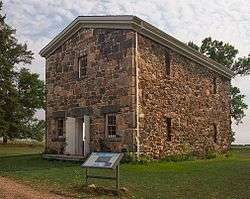Lower Sioux Agency
The Lower Sioux Agency, or Redwood Agency, was the federal administrative center for the Lower Sioux Indian Reservation in what became Redwood County, Minnesota, United States. It was the site of the Battle of Lower Sioux Agency on August 18, 1862, the first organized battle of the Dakota War of 1862. Today it is a historic site managed by the Lower Sioux Community in partnership with the Minnesota Historical Society. The site contains an interpretive center, self-guided trails, and a restored 1861 stone warehouse which is listed on the National Register of Historic Places.[2]
Lower Sioux Agency | |
 The Lower Sioux Agency warehouse from the northwest | |
| Location | 32469 County Hwy. 2, Sherman Township, Redwood County, Minnesota, USA |
|---|---|
| Nearest city | Morton, Minnesota |
| Coordinates | 44°31′34″N 94°57′28″W |
| Area | 122.86 acres (49.72 ha) |
| Built | 1853–1862 |
| NRHP reference No. | 70000308 [1] |
| Added to NRHP | 1970-09-22 |
History
The Lower Sioux Agency was established in 1853 by the United States government, to oversee the newly created Lower Sioux Indian Reservation.[2] This reservation was to be the home for the Mdewakanton and Wahpekute bands following the 1851 Treaty of Mendota.
On August 15, 1862, the Lower Sioux turned to the Agency staff for supplies. Representatives of the northern Sissetowan and Wahpeton Dakota bands had successfully negotiated to obtain food at the Upper Sioux Agency on August 4. However Thomas J. Galbraith, the Indian agent in charge, rejected the Lower Sioux bands as he would not distribute food to these bands without payment. At a meeting of the Dakota, the U.S. government and local traders, the Dakota representatives asked the representative of the government traders, Andrew J. Myrick, to sell them food on credit. His response was said to be, "So far as I am concerned, if they are hungry let them eat grass or their own dung."[3]
On August 16, 1862, the treaty payments to the Dakota arrived in St. Paul, Minnesota, and were brought to Fort Ridgely the next day. They arrived too late to prevent violence. On August 17, 1862, four young Dakota men were on a hunting trip in Acton Township, Minnesota, during which one stole eggs and then killed five white settlers.[4] Soon after, a Dakota war council was convened and their leader, Little Crow, agreed to continue attacks on the European-American settlements to try to drive out the whites.
On August 18, 1862, Little Crow led a group that attacked the Lower Sioux Agency. Andrew Myrick was discovered trying to escape through a second-floor window of a building at the agency. Myrick's body later was found with grass stuffed into his mouth because of his recent statement (See above). The warriors burned the buildings at the Lower Sioux Agency, giving enough time for settlers to escape across the river at Redwood Ferry. Minnesota militia forces and B Company of the 5th Minnesota Volunteer Infantry Regiment sent to quell the uprising were defeated at the Battle of Redwood Ferry. Twenty-four soldiers, including the party's commander (Captain John Marsh), were killed in the battle. Throughout the day, Dakota war parties swept the Minnesota River Valley and near vicinity, killing many settlers. Numerous settlements including the Townships of Milford, Leavenworth and Sacred Heart, were surrounded and burned and their populations nearly exterminated.
Current use
Self-guided trails take visitors around the site. The 1861 granary is the only surviving structure from the agency. Interpretive signs mark the locations of other features, including the location of the Redwood Ferry crossing the Minnesota River. Period gardens and plots demonstrate differences between traditional Dakota and Euro-American farming.[2]
References
- "National Register Information System". National Register of Historic Places. National Park Service. March 15, 2006.
- "Lower Sioux Agency". Minnesota Historical Society. Retrieved 2012-08-29.
- Dillon, Richard H. (1920). North American Indian Wars. City: Booksales. p. 126.
- Furst, Jay (22 December 2012). "Dakota War timeline". Rochester Post-Bulletin. Retrieved 27 December 2012.